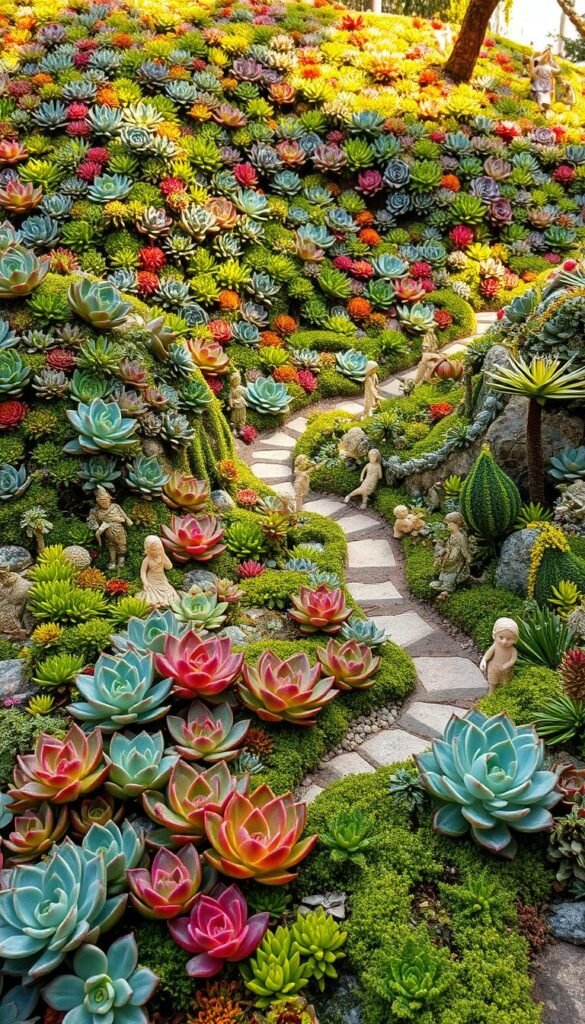Imagine creating a tiny, magical world where creativity meets nature. Miniature landscapes let you craft whimsical scenes that spark joy and relaxation. These projects aren’t just for kids—they’re a refreshing escape for adults, too. Best of all, you don’t need a green thumb to succeed.
Drought-tolerant varieties thrive in small spaces, making them perfect for busy lifestyles. Their unique shapes and colors add texture to your design, while their resilience reduces watering needs. This combination turns plant care into a simple, rewarding routine.
Starting small? These setups work indoors or outdoors—on tabletops, shelves, or patios. They’re also a fantastic way to teach younger family members about nurturing living things. Watch their eyes light up as tiny mushrooms or miniature benches appear among the foliage!
Whether you’re new to gardening or a seasoned pro, this hobby blends artistry with practicality. You’ll find endless ways to personalize your creation, from rustic themes to modern arrangements. Ready to unlock your imagination? Let’s dive into the secrets of building your own enchanting oasis.
Embracing the Magic of Fairy Gardens
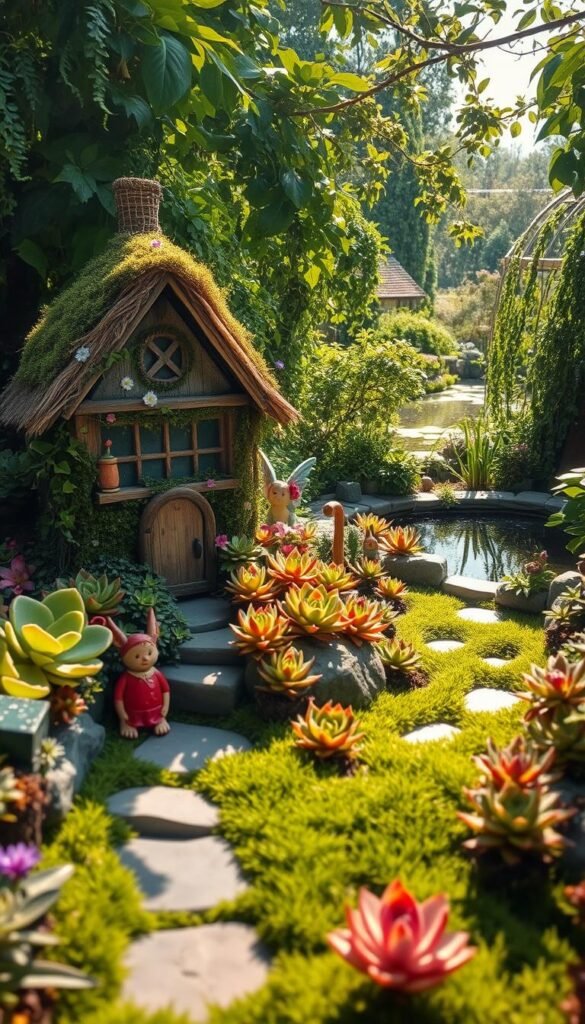
Childhood daydreams can bloom anew in miniature landscapes where creativity knows no bounds. These living dioramas invite you to reshape memories into tangible art, blending nostalgia with natural beauty. Like flipping through a beloved picture book, each element whispers possibilities.
Rediscovering Your Inner Child
Remember how mud pies and stick forts felt like grand adventures? Crafting tiny worlds revives that fearless experimentation. There’s no “right way” to place pebbles or position miniature chairs—only what makes your heart skip.
“Play is the highest form of research.”
You might be surprised how arranging tiny stones can melt away stress. A 2021 University of Colorado study found that tactile creative activities reduce cortisol levels by 28% on average.
Inspiration from Storybook Landscapes
Draw ideas from classic tales while adding your twist:
| Literary Theme | Garden Element | Modern Twist |
|---|---|---|
| Enchanted Forest | Moss carpets | Glow-in-the-dark pebbles |
| Desert Oasis | Sand dunes | Recycled glass crystals |
| Mountain Retreat | Mini boulders | Tiny solar-powered lights |
Notice how textures tell stories? Rough bark becomes castle walls. Smooth succulents mimic alien flora. Every choice whispers, “What if…”—the same question that fueled childhood adventures.
Understanding the Benefits of Succulent Fairy Gardens
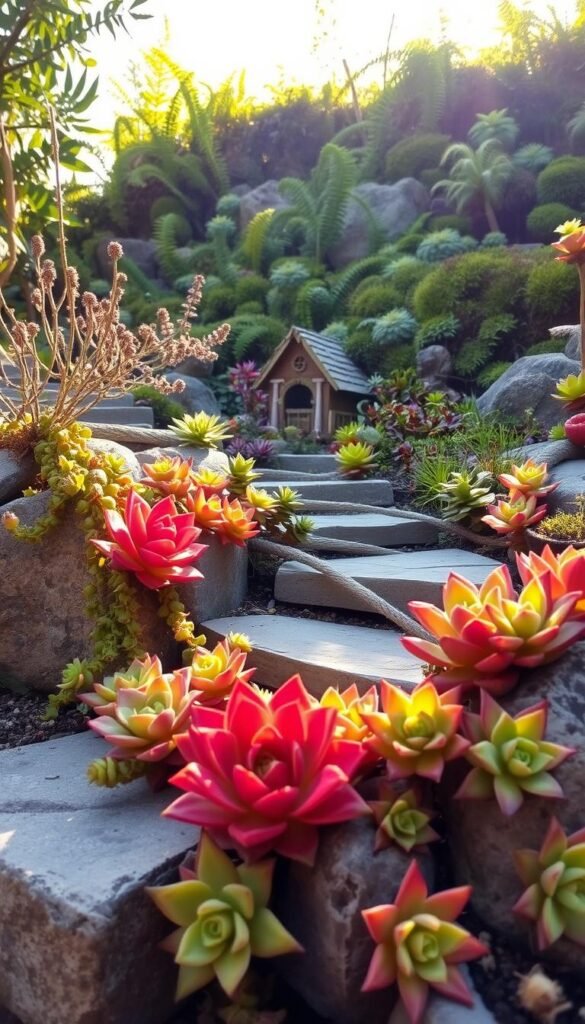
In a fast-paced world, tiny gardens provide a sanctuary for creativity and calm. These living artworks do more than beautify your space—they offer tangible wellness perks while fitting seamlessly into modern routines. Let’s explore how these mini ecosystems enrich your life.
Stress Relief and Creative Expression
Arranging stones or positioning tiny furniture becomes active meditation. Research shows tactile activities like gardening lower cortisol levels by up to 28%. Your hands shape the landscape while your mind unwinds, creating a flow state that melts tension.
Design choices spark imagination. Will that jade plant become a towering tree? Could pebbles form a winding path? There’s no wrong answer—only opportunities to experiment. As one therapist notes, “Miniature crafting lets adults play without judgment, rebuilding neural pathways dulled by daily stress.”
Low-Maintenance Living for Busy Lifestyles
Thriving on neglect, these plants forgive forgotten waterings. Most varieties need hydration just once every 2-3 weeks. Pair them with low-maintenance plants for texture contrast without added work.
Busy professionals love how these gardens:
- Require 5 minutes weekly for care
- Grow happily in dim offices or sunny kitchens
- Stay vibrant during vacations
Whether you’re juggling work deadlines or family commitments, this hobby adapts to your schedule. The joy comes from watching your tiny world evolve, not from constant upkeep.
Fairy Garden Ideas with Succulents: Hardy Plants for Stress-Free Maintenance
Small wonders thrive where others struggle. These botanical survivors evolved to conquer harsh deserts, making them natural champions in confined spaces. Their fleshy leaves act as built-in water reservoirs, letting them shrug off irregular care for weeks.
Design possibilities explode with their diversity. Picture spiky agaves standing guard like desert sentinels or rosette-shaped echeverias mimicking blooming flowers. Some varieties blush pink under sunlight, while others flaunt silvery-blue hues perfect for moonlit themes.
- Slow growth preserves your layout’s proportions
- Thick leaves resist drying out in shallow containers
- Drought tolerance forgives missed waterings
Ever left a project untouched for a month? One gardener confessed, “My jade plant thrived while I recovered from surgery—it even bloomed!” This resilience makes them ideal for unpredictable schedules.
Texture plays a starring role too. Fuzzy kalanchoes suggest cozy cottages, while smooth sedums mirror modern architecture. Pair trailing varieties with upright types to craft depth without overcrowding. Your tiny landscape stays vibrant, not overgrown.
“They’re the ultimate ‘set and forget’ plants for imaginative spaces.”
Choosing the Perfect Container and Well-Draining Soil
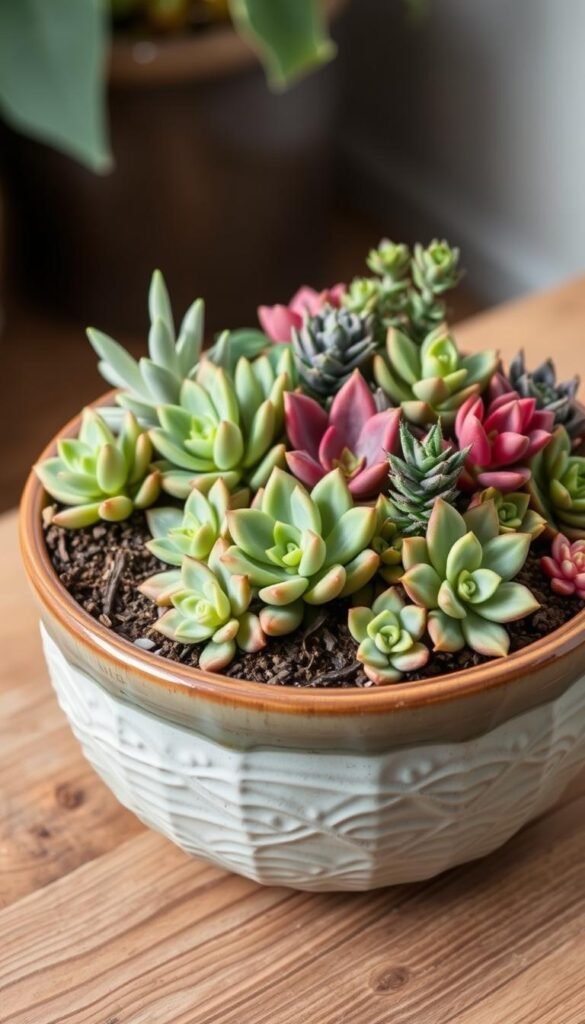
Your miniature oasis starts with two key choices: where to plant and what’s beneath the roots. The right vessel keeps plants healthy while reflecting your style, and the soil mix determines whether they flourish or drown. Get this duo right, and your creation becomes nearly self-sustaining.
Container Options: From Teacups to Terrariums
Think shallow and breathable. Ceramic pots with holes work, but why not repurpose that cracked birdbath or vintage teacup? Drainage holes are non-negotiable—they let excess water escape. No holes? Layer pebbles at the bottom before adding soil.
Materials matter. Porous terra cotta helps soil dry faster than glazed ceramics. Wooden crates add rustic charm but may rot—line them with plastic first. One gardener transformed an old toolbox: “I drilled holes through the metal—now it’s a desert caravan scene!”
Mixing Soil for Ideal Succulent Growth
Store-bought cactus mix works, but crafting your own ensures perfection. Blend two parts potting soil with one part coarse sand and one part perlite. This gritty combo mimics their natural habitat, letting roots breathe while preventing sogginess.
Test your mix: squeeze a handful. If it crumbles immediately, you’ve nailed it. As horticulturist Maya Patel advises, “Well-draining soil isn’t just dirt—it’s an insurance policy against overwatering disasters.” Refresh it annually to maintain nutrient balance and structure.
Selecting the Ideal Succulents for Your Fairy Garden
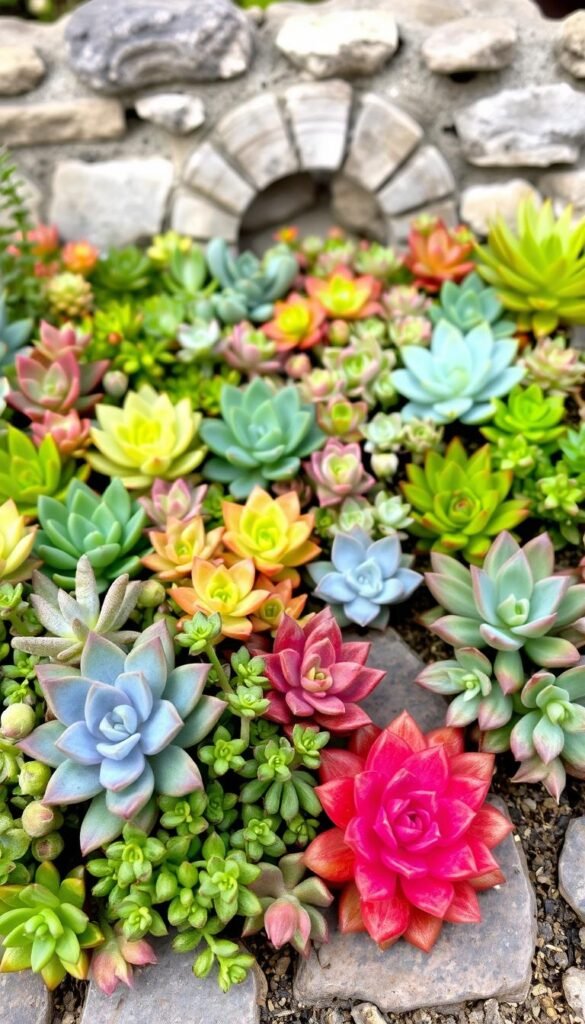
Crafting a miniature paradise begins with choosing botanical stars that stay small yet striking. Focus on slow-growing types that maintain their proportions over time. This ensures your tiny world doesn’t outgrow its charm within weeks.
Miniature Marvels: Echeveria and Beyond
Echeveria steals the show with rosette shapes resembling stone flowers. Sedum varieties like ‘Dragon’s Blood’ mimic tiny rose bushes, while Haworthia’s striped leaves add geometric flair. These natural miniatures thrive in shallow containers without crowding.
| Type | Key Feature | Design Role |
|---|---|---|
| Burro’s Tail | Trailing stems | Waterfall effects |
| Jade Plant | Tree-like form | Focal point |
| Hens and Chicks | Cluster growth | Ground cover |
Texture and Color Symphony
Mix fuzzy Panda plant leaves with glossy Crassula varieties for tactile contrast. Deep purple Echeveria ‘Black Prince’ pairs beautifully with lime-green Sedum ‘Angelina’. One gardener shared, “Using three contrasting colors made my scene pop like a 3D painting!”
Consider growth habits when arranging. Upright types create vertical interest, while trailing ones spill over edges naturally. This layered approach adds depth without overwhelming your tiny ecosystem. Your choices become the paintbrush strokes of living art.
Planning and Sketching Your Miniature Landscape
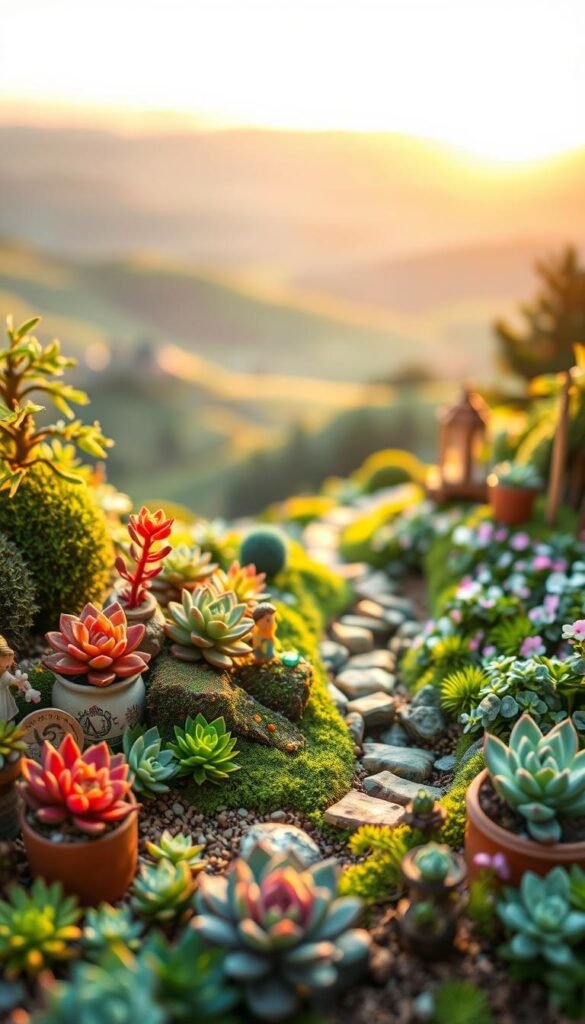
Designing your tiny ecosystem begins with a blueprint. Sketching helps visualize how elements interact before you plant. Start by marking anchor points—like a cottage or stone path—to establish your layout’s backbone. These features guide placement of smaller details, ensuring harmony in your living diorama.
Balance is key. Taller plants should frame scenes without blocking sightlines. Use low-growing varieties near pathways to maintain visibility. A 2023 National Gardening Survey found 68% of enthusiasts improved designs by sketching first, avoiding overcrowding issues.
| Design Element | Purpose | Scale Tip |
|---|---|---|
| Fairy House | Focal point | 1:12 ratio to plants |
| Pathways | Guide exploration | Width = 2-3 pebbles |
| Plant Layers | Create depth | Vary heights by 1-2″ |
Think like a movie set designer. Winding trails suggest adventure, while clustered stones hint at hidden nooks. One creator shared, “I mapped sightlines from all angles—now every glance reveals new details!”
Designate zones for different moods:
- Sunny clearings for gatherings
- Shaded corners for quiet moments
- Elevated areas for dramatic backdrops
Your sketch becomes the roadmap for a cohesive story. Adjust as you build, but let that initial vision steer decisions. After all, the magic lies in seeing your imagined world take root.
Adding Whimsical Accessories and Fairy Details
Transform ordinary objects into enchanted treasures that bring your miniature world to life. Whether crafting from scratch or hunting for pre-made pieces, accessories infuse personality into your tiny realm. The key? Balancing creativity with scale to maintain harmony between plants and décor.
DIY Decorations and Thrift Store Finds
Turn acorn caps into bowls or convert wine corks into rustic benches. Thrift stores offer endless possibilities—look for:
- Broken jewelry for sparkling pathways
- Dollhouse furniture needing fresh paint
- Miniature picture frames as fairy windows
One creative gardener shared, “I turned a chipped teacup into a glowing mushroom house using craft-store resin!” Natural materials like birch bark make excellent roofing, while pebbles become stepping stones.
| DIY vs. Store-Bought | Cost | Uniqueness | Time Investment |
|---|---|---|---|
| Handmade Items | $0-$5 | 100% Original | 1-3 Hours |
| Retail Pieces | $8-$25 | Mass-Produced | Instant Use |
Incorporating Houses and Miniature Characters
Let tiny dwellings anchor your design. Position a weathered birdhouse as a central cottage, then surround it with figurines telling a story. A 2022 Miniature Trends Report showed 73% of enthusiasts use houses as focal points, flanked by supporting elements like:
- Resin mushrooms peeking through foliage
- Mini lanterns lining pebble paths
- Ceramic animals guarding hidden clearings
Remember: accessories should complement, not dominate. As one designer advises, “Let plants remain the stars—decorations are the supporting cast.”
Step-by-Step Guide to Planting Your Succulent Garden
Let’s roll up our sleeves and bring your vision to life. Whether you’re using a repurposed tray or a handmade planter, these steps ensure your tiny ecosystem thrives. Start by gathering your materials—gloves, tweezers, and a soft brush help handle delicate specimens.
Preparing Your Container and Soil
Fill your chosen vessel ¾ full with gritty soil mix. Gently tap the container to settle the blend without compacting it. If roots cling to nursery pots, squeeze the sides to loosen them. Tease apart tangled roots with your fingers—this encourages outward growth.
| Container Material | Pros | Considerations |
|---|---|---|
| Terra Cotta | Breathable | Dries soil faster |
| Ceramic | Stylish | Needs drainage holes |
| Concrete | Durable | Heavy when filled |
Positioning Succulents for Optimal Growth
Create shallow holes using a spoon handle. Place taller varieties toward the back and trailing types near edges. Leave 1-2 inches between plants for airflow and future growth. Bury only the root ball—exposed stems prevent rot.
Add accessories after planting. Secure figurines with waterproof glue, and press pebble paths lightly into the soil. As master gardener Elena Torres advises, “Treat each placement like a chess move—strategic yet playful.”
- Rotate containers weekly for even sun exposure
- Use chopsticks to adjust tiny decorations
- Mist soil instead of pouring water initially
Watering Techniques and Routine Maintenance
Nurturing your miniature ecosystem requires a gentle touch and smart habits. By mastering a few simple routines, you’ll keep plants thriving while preserving their storybook charm. Let’s explore how to balance hydration with creative care.
When and How to Water Your Garden
Check soil moisture by pressing your fingertip an inch deep. If it feels parched, it’s time for a drink. Always wait until the soil dries completely—usually every two weeks—to avoid root rot. Overeager watering causes more harm than neglect.
When hydrating, soak the earth until water flows from drainage holes. This ensures roots absorb what they need. Let excess drain fully—never let pots sit in pooled water. For precision, use a narrow-spout watering can to target soil, not leaves.
Spot thirsty plants by wrinkled leaves or gaps between soil and container edges. Bright indirect light keeps colors vibrant without scorching delicate foliage. Rotate containers weekly for even sun exposure.
Learn more about proper watering techniques to refine your routine. With practice, you’ll develop an instinct for your garden’s needs, turning maintenance into mindful moments of connection.

